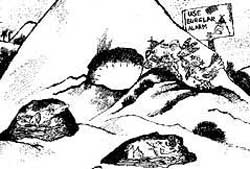Who ate my house?
 rampant harvesting of nests has caused a decline in the populations of the Edible-nest Swiftlet ( Collocalia fuciphagia ), according to R Sankaran, scientist in the division of ecology at the Salim Ali Centre for Ornithology and Natural History ( sacon ) in Coimbatore, Tamil Nadu. Sankaran has undertaken a study to assess the impact of nest collection on the swiftlet's population. In India, the bird is found only in the Andaman and Nicobar Islands. Its nests are edible, and one of the most expensive animal products in the world. The species is not included in the Convention on International Trade in Endangered Species of Wild Fauna and Flora ( cites ). This means that international trade in its nests cannot be checked easily.
rampant harvesting of nests has caused a decline in the populations of the Edible-nest Swiftlet ( Collocalia fuciphagia ), according to R Sankaran, scientist in the division of ecology at the Salim Ali Centre for Ornithology and Natural History ( sacon ) in Coimbatore, Tamil Nadu. Sankaran has undertaken a study to assess the impact of nest collection on the swiftlet's population. In India, the bird is found only in the Andaman and Nicobar Islands. Its nests are edible, and one of the most expensive animal products in the world. The species is not included in the Convention on International Trade in Endangered Species of Wild Fauna and Flora ( cites ). This means that international trade in its nests cannot be checked easily.
The nest of the swiftlet is a delicacy that dates back to antiquity. It gained commercial importance in the 16th century, when the Chinese began to value the culinary delicacy of the bird's nest soup. The demand has grown steadily, and the swiftlet has suffered
Related Content
- A global incentive scheme to reduce carbon emissions
- Order of the National Green Tribunal regarding construction of a housing project without environment clearance, Lucknow, Uttar Pradesh, 23/04/2024
- Adopting a low-emission and climate-resilient development pathway in Nepal
- Financing industrial decarbonization: challenges and solutions for India’s iron and steel sector
- Order of the National Green Tribunal regarding encroachment and deforestation of Senchal Wildlife Sanctuary, 10/04/2024
- Order of the National Green Tribunal regarding unauthorized and illegal construction of houses, shops and other commercial establishments in Noida and Greater Noida, Uttar Pradesh, 02/04/2024
